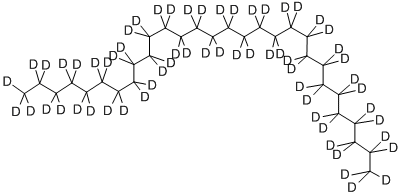n-Heptadecane
Synonym(s):n-Heptadecane
- CAS NO.:629-78-7
- Empirical Formula: C17H36
- Molecular Weight: 240.47
- MDL number: MFCD00009002
- EINECS: 211-108-4
- SAFETY DATA SHEET (SDS)
- Update Date: 2025-12-17 09:49:31

What is n-Heptadecane?
Chemical properties
colourless liquid or white solid
The Uses of n-Heptadecane
n-Heptadecane is used as an internal standard to study the first direct comparison of kava lactone extraction efficiencies. It plays an important role as a suspended solvent used for the extraction and concentration of essential oil. It is used as a precursor in the production of iminoctadine triacetate
What are the applications of Application
Heptadecane was used as an internal standard in the reaction to study the first direct comparison of kava lactone extraction efficiencies. It was also used as the appropriate suspended solvent for the extraction and concentration of EO (essential oil).
Definition
ChEBI: Heptadecane is a straight-chain alkane with 17 carbon atoms. It is a component of essential oils from plants like Opuntia littoralis and Annona squamosa. It has a role as a plant metabolite and a volatile oil component.
Preparation
Gas-phase dehydrogenation of n-alkanes over noble-metal catalysts yield the corresponding n-alkenes at low conversion rates (ca. 10%) with predominantly internal double bonds. The corresponding alkenes can be isolated in high purity by selective molecular-sieve processes.
General Description
Hexagonal leafs.
Air & Water Reactions
Flammable. Insoluble in water.
Reactivity Profile
Saturated aliphatic hydrocarbons, such as N-HEPTADECANE, may be incompatible with strong oxidizing agents like nitric acid. Charring of the hydrocarbon may occur followed by ignition of unreacted hydrocarbon and other nearby combustibles. In other settings, aliphatic saturated hydrocarbons are mostly unreactive. They are not affected by aqueous solutions of acids, alkalis, most oxidizing agents, and most reducing agents. When heated sufficiently or when ignited in the presence of air, oxygen or strong oxidizing agents, they burn exothermically to produce carbon dioxide and water.
Fire Hazard
Flash point data for N-HEPTADECANE is not available,but N-HEPTADECANE is probably combustible.
Properties of n-Heptadecane
| Melting point: | 20-22 °C(lit.) |
| Boiling point: | 302 °C(lit.) |
| Density | 0.777 g/mL at 25 °C(lit.) |
| vapor density | 8.3 (vs air) |
| vapor pressure | 1 mm Hg ( 115 °C) |
| refractive index | n |
| Flash point: | 300 °F |
| storage temp. | room temp |
| solubility | Chloroform (Slightly), Hexane (Slightly) |
| form | Liquid After Melting |
| Specific Gravity | 0.7783 |
| color | Clear colorless |
| Water Solubility | Immiscible with water. |
| FreezingPoint | 21.0 to 24.0 ℃ |
| BRN | 1738898 |
| Stability: | Stable. Incompatible with strong oxidizing agents. Combustible. |
| CAS DataBase Reference | 629-78-7(CAS DataBase Reference) |
| EPA Substance Registry System | Heptadecane (629-78-7) |
Safety information for n-Heptadecane
| Signal word | Danger |
| Pictogram(s) |
 Health Hazard GHS08 |
| GHS Hazard Statements |
H304:Aspiration hazard |
| Precautionary Statement Codes |
P331:Do NOT induce vomiting. P301+P310:IF SWALLOWED: Immediately call a POISON CENTER or doctor/physician. P405:Store locked up. P501:Dispose of contents/container to..… |
Computed Descriptors for n-Heptadecane
New Products
4,4-Difluoropiperidine hydrochloride tert-butyl 9-methoxy-3-azaspiro[5.5]undecane-3-carboxylate Indole Methyl Resin N-Isopropylurea N,N-Dicyclohexylcarbodiimide(DCC) MELDRUMS ACID 5-METHYLISOXAZOLE-4-CARBOXYLIC ACID Magnessium Bis glycinate Zinc ascorbate 1-bromo-2-butyne 2-acetamidophenol 9(10H)-anthracenone Erythrosin B, 4-Piperidinopiperidine 2-((4-morpholinophenylamino) (methylthio) methylene) malononitrile 2,4-dihydroxybenzaldehyde 3-(4-morpholinophenylamino)-5-amino-1H-pyrazole-4-carbonitrile Methyl 2-methylquinoline-6-carboxylate 2,6-dichloro-4-nitropyridine 4-Bromo-2-chlorobenzonitrile 2-(benzylamino)acetic acid hydrochloride 4-(tert-Butoxycarbonylamino)but- 2-ynoic acid 3,4-dihydro-2H-benzo[b][1,4]dioxepine 1-Phenyl-1-cycloprppanecarboxylicacidRelated products of tetrahydrofuran








You may like
-
 n-Heptadecane CAS 629-78-7View Details
n-Heptadecane CAS 629-78-7View Details
629-78-7 -
 n-Heptadecane CAS 629-78-7View Details
n-Heptadecane CAS 629-78-7View Details
629-78-7 -
 n-Heptadecane CAS 629-78-7View Details
n-Heptadecane CAS 629-78-7View Details
629-78-7 -
![Heptadecane [Standard Material for GC] CAS 629-78-7](https://img.chemicalbook.in//Content/image/CP5.jpg) Heptadecane [Standard Material for GC] CAS 629-78-7View Details
Heptadecane [Standard Material for GC] CAS 629-78-7View Details
629-78-7 -
 n-Heptadecane 98.00% CAS 629-78-7View Details
n-Heptadecane 98.00% CAS 629-78-7View Details
629-78-7 -
 n-Heptadecane, puriss 99%+ CAS 629-78-7View Details
n-Heptadecane, puriss 99%+ CAS 629-78-7View Details
629-78-7 -
 Heptadecane CAS 629-78-7View Details
Heptadecane CAS 629-78-7View Details
629-78-7 -
 20677-73-0 (2,2-diethoxyethyl)methylamine 98%View Details
20677-73-0 (2,2-diethoxyethyl)methylamine 98%View Details
20677-73-0
